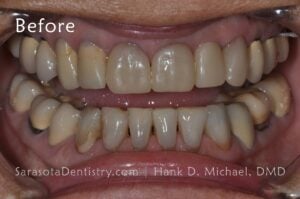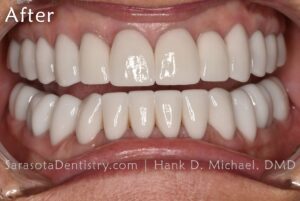Many people strongly desire that movie-star white smile but feel insecure about one or more imperfections. Black triangles between teeth make up just one of those cosmetic flaws. They appear due to a shadow created by a space between the teeth and gums and often look like a piece of food stuck between the teeth – especially in photos. These black triangles can sometimes require more than just a cosmetic fix. Instead, there are significant dental health reasons to correct them.
What Are Black Triangles in Teeth?

Not all gaps signify a problem. Some people naturally have slight or moderate spaces between their teeth. However, recent gaps that seem to widen over time need attention. Besides being unsightly, black triangles can catch bacteria and food, leading to cavities and other dental problems.
What Causes Black Triangles in Teeth?
Black triangles between teeth form for several reasons. The cause can often determine the seriousness of the dental issue and inform proper treatment.
Forceful Dental Hygiene
There can be too much of a good thing, such as brushing too hard and using too much force when brushing or flossing. Such habits can damage the gums, creating gaps and contributing to gum disease. This is rarely the cause, but patients commonly think this is what the cause is. They then start to slack on the dental hygiene which may actually lead to bigger problems.
Bone Loss
Conditions like osteoporosis and gum disease can lead to the loss of bone at the tooth’s base. You also tend to experience gum recession when you lose bone, often causing black triangles. It is important to brush, floss and proxy brush daily to minimize recession caused by gum disease
Tooth Shape
The shape of your teeth can play a role in the likelihood of developing black triangles. Rectangular teeth that are equal in width at the bottom and top might not be as susceptible as incisors, typically narrower near the gums. Teeth with a more triangular shape are more likely to develop gaps at the gum line.
Gum Recession
Gum recession often results from gum disease, causing the gums to recede or thin out, leaving empty spaces. Smoking and age are other causes of recession, contributing to black triangles in teeth, increased plaque, cavities, and tooth decay.
Prior Orthodontic Care
Having had braces or other forms of orthodontic care might cause small gaps because of tooth repositioning. Also, parts of braces like bands or other orthodontic components can damage the gums. Adults with braces are 22%-36% more likely to develop black triangles, depending on the placement of the braces.
If I Have Black Triangles, How Do I Get Rid of Them?
If you start to see black triangles developing, do not despair. Fortunately, there are a number of techniques available to fix black triangles in your teeth and improve your smile.
Regular and Moderate Dental Hygiene
Regular and proper dental hygiene is usually the easiest way to prevent black triangles between your teeth. The American Dental Association (ADA) recommends flossing every day and brushing twice daily to maintain the health and look of your teeth. Moreover, you should floss and brush carefully and avoid hurting your gums. If the black triangles are mild and you have healthy gums, improving your dental routine might strengthen your gums and reduce the gaps.
Braces
If your black triangles are the result of some teeth being crooked or out of place, you might ask your dentist about braces. This treatment might help close those gaps. As with many orthodontic procedures, braces take time to work, and you will need some patience to see the results you want.
Bonding
An option that does not require surgery is bonding, which involves filling in the gaps with composite resin. Your dentist can decide whether to use pink, tooth-colored, or a combination of both to close the spaces. Depending on the patient’s needs, this procedure can take weeks or months of appointments because the dentist applies the resin in thin layers to create a more natural look. This gradual process also gives the gums enough time to heal and adapt.
Veneers

Bioclear
As an alternative to veneers and is a state-of-the-art composite resin bonding, Bioclear is a viable solution to fix teeth that are broken, chipped, damaged from grinding, or stained. This procedure is also appropriate for correcting spaces and black triangles. Using the Bioclear matrix system, a dentist slips thin, anatomically correct, mylar sheets under the gum line and around the teeth. They then inject a liquid composite into the sheets to build a new tooth surface. After the resin hardens, the dentist shapes the teeth to look beautiful and free of any black triangles.
Gum Grafts
Patients with black triangles resulting from severe gun recession might consider gum grafting, which a periodontist performs. During the surgery, the periodontist removes a small amount of tissue from the roof of the mouth and grafts it over the receding sections of the gums. Some patients might also need bone grafts if bone loss has occurred.
Hyaluronic Acid Treatment
For less severe black triangles, hyaluronic acid injections can rebuild lost gum tissue. More research needs to be done to confirm its long-term effects. However, this procedure is less painful than most corrective surgeries and generally takes less recovery time.
How Can I Prevent Black Triangles?
The best cure for black triangles is prevention. Daily brushing and flossing improve mild cases of black triangles, and they prevent them from developing in the first place.
Despite your best efforts, consult your dentist if you start to see black triangles forming. Early detection and intervention can prevent a mild problem from progressing, requiring more drastic remedies.
- Dental Implant Pros and Cons - August 26, 2023
- Receding Gums Stages - August 12, 2023
- When Is It Too Late for Gum Grafting? - July 8, 2023


